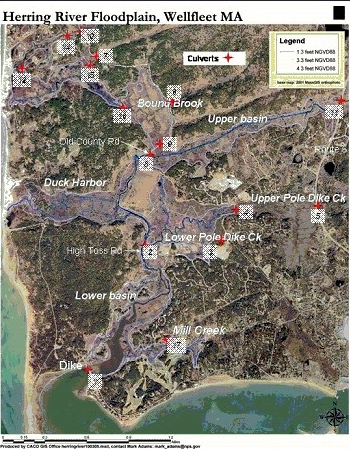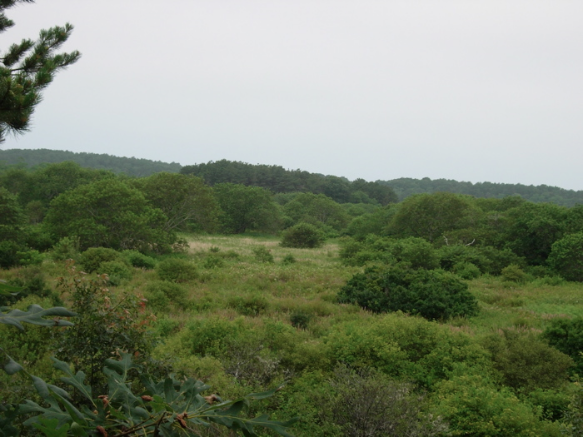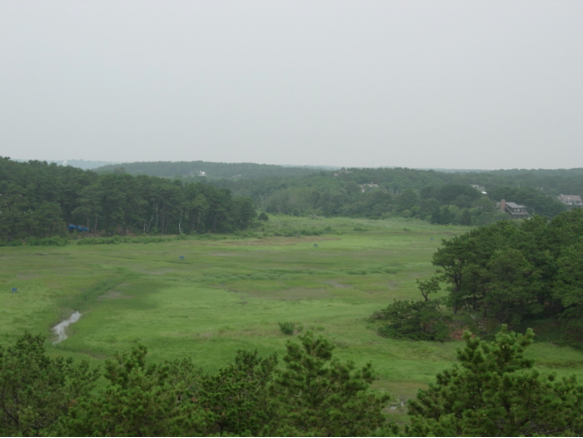DER Coastal Projects Update Herring River, Wellfleet
UPDATE AUGUST 2012:
The largest proposed salt marsh restoration project on the North Atlantic Coast has just been updated. Read the excerpt from the department of environmental resources' latest newsletter posted below. Safe Harbor supports salt marsh restoration. Safe Harbor director, Gordon Peabody was chair of the Herring River Technical Committee which reviewed all previous technical information regarding the river and developed the conceptual restoration plan. More information regarding development of that plan can be found elsewhere within this post, and the Herring River category.
Herring River Estuary July 4, 2004
Aerial view (looking north) of a portion of the Herring River Estuary in Wellfleet. The dike, acting as the main source of restricting tidal flow to the estuary, is in the foreground.
The Draft Environmental Impact Statement/Report for this large-scale restoration project, which would restore tidal flow to an approximately 1,000 acre area in and along the Herring River estuary, is scheduled to be released in October, and public informational meetings about, and a comment period on, the project are expected to be scheduled shortly thereafter. This is the largest tidal estuary restoration ever undertaken in Massachusetts and the North Atlantic coast of the United States. DER has served as a core project partner over the past decade and has contributed substantial technical and financial resources to support project development.
“The once proud and economically supportive herring river on Cape Cod, being forced to “Breathe through a straw” with grossly undersized culverts, for 100 years. Social influences diked this 1,200 acre river system and social influences will be required to give this river back it’s voice. ”
In the meantime, the Friends of Herring River have produced Return of the Tides: The Herring River Restoration Project, a video developed to educate the public about the value of a healthy salt marsh estuary and the expected benefits or restoring the historic tidal flow of the Herring River Estuary. For thousands of years, this estuary was highly productive and provided feeding and nursery habitat for commercially important fish and shellfish, cycled nutrients and sediment to improve water quality, produced salt hay for animal fodder, and buffered storm surges. Then, throughout the nineteenth and early twentieth centuries, road and railroad dikes were built across the river’s floodplain, bisecting the salt marshes and dramatically altering natural tidal patterns. In addition to the group’s website, Return of the Tides may also be viewed on Vimeo and (with subtitles) on an electronic bulletin board at the Beach Sticker Office in Wellfleet. [Click here and here for additional info on this project.]
Diked for 99 years, the natural resources of Wellfleet's Herring River may get a second chance.
The diked Herring River estuary in Wellfleet, Massachusetts is being considered for restoration. Nearly 100 years ago, the 1,200 acre salt marsh system was reduced to 7 acres. Upper reaches of historic Cape Cod tidelands stretch four miles North into the town of Truro. During the past 100 years, the ecological values of the salt marsh have degraded. Upland vegetation began invading the flood plain. Lack of flushing contributed to low levels of dissolved oxygen. Acidic conditions supported mosquitoes and high levels of bacteria. Fish kills and routine closures of adjacent shellfish beds eventually received attention. In August of 2005, a Memorandum of Understanding (MOU), between the town of Wellfleet and the Cape Cod National Seashore, detailed the process for considering restoration.


A Stakeholder Committee was appointed, to solicit local concerns about potential restoration. A Technical Committee was formed to study the existing scientific information available on the Herring River's existing conditions. The Technical Committee was also directed to respond to Stakeholder issues and make a recommendation on the feasibility of restoration to the Wellfleet Board of Selectmen. In January, 2006, the Wellfleet Board of Selectmen reviewed the Full Report of the Technical Committee.
The Technical Committee's report recommended "that tidal restoration of the Herring River Salt Marsh is feasible and will provide numerous and substantial public benefits" The recommendation continued, "....significant improvements in water quality would provide subsequent public health, recreational, environmental and economic benefits.". Specifically included was "a new structure capable of full tidal restoration....incorporating controlled gates to provide incremental increases in tidal exchange. This would allow for well thought out management, supervision, monitoring and evaluation."
Related Links:
CLICK HERE FOR RESTORATION PLANNING DOCUMENTS
CLICK HERE FOR THE NEW HERRING RIVER RESTORATION COMMITTEE
CLICK HERE FOR LEARNING FROM AUSTRALIA'S ESTUARIES
HRTC_CRP_COVER_LTR
CLICK ON THE FOLLOWING LINKS FOR THE MOST RECENT UPDATE ON THE WELLFLEET HERRING RIVER RESTORATION:
http://www.capecodtimes.com/article/20141201/NEWS/141209992/0/SEARCH
http://www.capecodtimes.com/article/20150204/NEWS/150209663/0/SEARCH
Want More Information?
1. Numerous additional documents are available upon request. Please contact Gordon Peabody at 508-237-3724 or click here gordonsafeharbor@yahoo.com
2. For access to most recent documents, such as agendas, draft plans, minutes and chairman's notes, go to the CURRENT DOCUMENTS page, at the very top of this page.
3. Restoration Brochure, background and general information. Just click on the link below to read the brochure.



